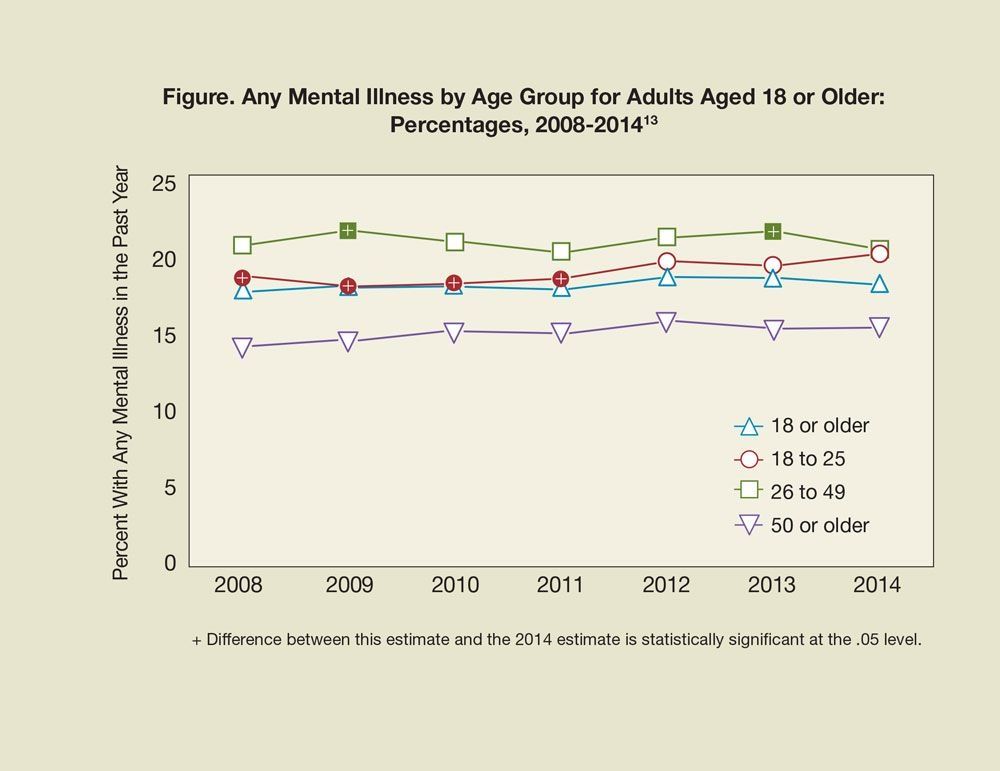The Astonishing Non-Epidemic of Mental Illness
The supposed “epidemic” of mental illness turns out to be mostly a myth in the US adult population, 2000-2015.
Figure

©MARTIN LISNER /Shutterstock

COMMENTARY
If you are waiting for a book bearing the title of this article, don’t hold your breath. No publisher or author would make more than a few nickels from sales. It’s much more exciting to write about the terrible “epidemic” of mental illness that has swept across our nation-and to expose the nefarious treatments and practices of Psychiatry (capital “P”) as the cause of this scourge.1
All this vituperation makes for good online chatter, and it certainly sells books. But from the standpoint of epidemiological science, the “epidemic of mental illness” narrative is-with a few qualifications-mostly fear-mongering drivel. When we carefully define an “epidemic” as “. . . an increase, often sudden, in the number of cases of a disease above what is normally expected in that population in that area . . .”-the definition used by the CDC-the so-called epidemic of mental illness among adults in the US proves largely illusory.2 And once we pull out the bottom card-the epidemic narrative-from the critics’ claim, the entire house of cards collapses. In addressing this issue, I am not taking aim at the “psychiatry is medicalizing normality” argument, which is itself dubious, but is at least worthy of serious discussion.3
Note that the CDC definition of “epidemic” applies to actual cases of disease-not to changing rates of diagnosis, which are subject to many socio-cultural variables. For example, a desperate parent’s attempt to secure special services for an autistic child may influence the clinician’s willingness to diagnose an autistic spectrum disorder. This is a critical point, since psychiatry’s critics do not claim merely that there is more diagnosis of schizophrenia or major depression; rather, they claim there are actually more people sick with these illnesses, owing to misguided or harmful psychiatric treatment. Ironically, their claim presupposes the “reality” of mental illness, thereby putting the epidemic-mongers at odds with mental-illness deniers-an intriguing schism within the anti-psychiatry movement.
The CDC definition of “epidemic” applies to
actual cases
of disease-not to changing
rates of
diagnosis,
which are subject to many socio-cultural variables.
The “epidemic” claim has been supported mainly on the basis of increasing US rates of psychiatric disability determinations over the past 50 years.4 But Social Security Administration disability determinations are notoriously susceptible to claimant preparation and administrative pressures, and they cannot be used as a legitimate index of disease incidence or prevalence.5
Let me hasten to add that there is indeed a growing population of persons with serious psychiatric illness who are not receiving adequate treatment. Most of them wind up either in prison or on the streets-a shameful deficiency in our mental health care that has been highlighted by Dr. Allen Frances,6 Dr. Fuller Torrey,7 and many others. As Dr. Torrey has observed, “. . . on any given day in the United States, half of all individuals with schizophrenia, or about one million people, are not being treated.”7 If there is an “epidemic” to be addressed in this country, it is this unconscionable neglect of our most severely impaired citizens.
A quick recap
In 2 previous articles on the bogus epidemic of mental illness in the US,8,9 the following conclusions were reached:
• There are no credible epidemiologic data showing that, in adults, the incidence or prevalence of schizophrenia, bipolar disorder, or MDD in the US has substantially increased over the past 2 or 3 decades, using DSM-III/IV or closely related criteria.
• Based on 2010 data, “National levels of psychological distress in adults have remained relatively stable for more than a decade.”10
• The prevalence of serious mental illness (SMI) in adults-conventionally defined by the National Institute of Mental Health as a psychiatric disorder “. . . resulting in serious functional impairment, which substantially interferes with or limits one or more major life activities”-changed very little in this country between roughly 2000 and 2010.10
We are now in a position to update some of these findings:
• In 2014, there were an estimated 9.8 million adults aged 18 or older in the US with SMI during the past year. This number represented 4.2% of all US adults. This figure is not significantly different from SMI rates determined in 2008 (3.7%) or 2012 (4.1%).11
• Using a standardized measure called “serious psychological distress” (SPD)-based on the Kessler-6 (K6) scale-3.8% of US adults aged 18 to 64 years experienced SPD in the past 30 days, during the first 9 months of 2015. This compares with SPD rates of 3.2% in 2012, 4.0% in 2013, and 3.4% in 2014. In the period from 2001 to 2004, 30-day SPD prevalence rates were approximately 3.1% of the US adult population. In short, there has been no significant increase in SPD in the period from 2001 to 2015.12
• The percentage of adults who had a past-year major depressive episode (MDE) remained stable between 2005 and 2014. The percentage of adults with a past-year MDE with severe impairment also remained stable between 2009 and 2014.13
• The percentage of adults aged 18 or older with any mental illness has remained essentially stable from 2008 to 2014 as shown in the Figure.13
Conclusion
The trends reported here are simply not consistent with the claim that current psychiatric treatments are worsening the severity of psychiatric illness, or increasing its frequency in this country-much less creating an “epidemic” of mental illness. That said, this review has been limited to persons 18 years or older and has covered principally the past 15 years. And, as always, our instruments of measurement, including household surveys, are imperfect and may miss cases of mental illness that have not occurred within the specified period of 30 days or a year. Moreover, there may be an increased incidence or prevalence of specific psychiatric disorders that is not being captured by non-diagnostic categories such as “serious mental illness” or “serious psychological distress.”
Let me be clear: “stable” rates of mental illness should occasion no joy. We must do much more than achieve a kind of stalemate in the battle against psychiatric disorders. Yet it is misleading and unfair to suggest that psychiatry is laboring under a “failed paradigm” (to use the term made famous by historian Thomas Kuhn14). First, there is no one paradigm that defines all of psychiatry or that dictates practice on the part of all psychiatrists. Perhaps that is part of the problem: psychiatry is still a relatively young field, still struggling to find the right “model” for understanding and treating mental illness.15 The present state of affairs does not represent a failed paradigm, so much as the daunting complexity of psychiatric illnesses; our incomplete knowledge of their causes; and, perhaps most important, the many barriers to appropriate and comprehensive mental health care in this country.
That said, we are learning more each year about the pathophysiology of psychiatric illnesses; and even now, psychiatric medications are, on average, about as effective as those used in most other medical specialties.16 But biology is only part of the required “paradigm.” We need to integrate our biological knowledge and somatic treatments with a humanistic program of care-one that addresses the psychological, social, and even spiritual aspects of the patients we treat.
No-there is no credible evidence of an “epidemic” of mental illness in this country, or in most other Western, industrialized countries.17 But there are still many miles to go, and many challenges to overcome, in our battle with psychiatric illness.
This article was originally posted on 9/27/2016 and has since been updated.
For further reading
Healy D, Le Noury J, Linden SC, et al. The incidence of admissions for schizophrenia and related psychoses in two cohorts: 1875–1924 and 1994–2010. BMJ Open. 2012;2:e000447. Section 11. http://bmjopen.bmj.com/content/2/1/e000447.full#sec-11. Accessed September 22, 2016.
This study from the UK finds a decline in admission incidence for schizophrenia from 2005 to 2010. The authors note that “. . . this cannot be explained in terms of administrative coding procedures or in terms of service changes. . . We have also in this database found a contemporary decline in admission rates of depressive psychoses.” While these data were gathered in North Wales, they lend no support to the claim that antipsychotic medication, which is widely used in the UK, is leading to clinical worsening of patients with schizophrenia or to an increased incidence of schizophrenia or affective psychosis.
To our readers: As per our policy, we ask that comments be accompanied by your names and professional titles. Thank you. -The Editors
Disclosures:
Acknowledgments: I wish to thank Peter Kramer, MD, for his helpful comments on an early draft; and Ronald C. Kessler, PhD, for pointing out some sources of epidemiological data. The views expressed here, however, are my own.
References:
References
1. Angell M. The epidemic of mental illness and the illusions of psychiatry, a two-part review in the New York Review of Books, 2011. http://www.nybooks.com/articles/2011/07/14/illusions-of-psychiatry. Accessed September 22, 2016.
2. http://www.cdc.gov/ophss/csels/dsepd/ss1978/lesson1/section11.html. Accessed September 22, 2016.
3. Pies RW. Does Psychiatry Medicalize Normality? Philosophy Now. November/December 2013. https://philosophynow.org/issues/99/Does_Psychiatry_Medicalize_Normality. Accessed September 22, 2016.
4. Whitaker R. Psychiatric drugs and the astonishing rise of mental illness in America. Ethical Human Psychology and Psychiatry, Volume 7, Number I, Spring 2005.
5. Ultimate Social Security Disability Guide: SSDI, SSI, How to Win, Information Social Security Disability Hearing and How to Prepare for Disability Hearing. http://www.ultimatedisabilityguide.com/disability_hearing.html. Accessed September 22, 2016.
6. Frances A. World’s Best-and Worst-Places To Be Mentally Ill. Psychiatric Times. December 29, 2015. http://www.psychiatrictimes.com/blogs/worlds-best-and-worst-places-be-mentally-ill. Accessed September 22, 2016.
7. http://www.treatmentadvocacycenter.org/component/content/article/2085-anatomy-of-a-non-epidemic-a-review-by-dr-torrey. Accessed September 22, 2016.
8. http://www.psychiatrictimes.com/blogs/couch-crisis/there-really-%E2%80%9Cepidemic%E2%80%9D-psychiatric-illness-us. Accessed September 22, 2016.
9. http://www.psychiatrictimes.com/blogs/bogus-epidemic-mental-illness-us. Accessed September 22, 2016.
10. http://archive.samhsa.gov/data/2k12/MHUS2010/MHUS-2010.pdf. Accessed September 22, 2016.
11. http://www.nimh.nih.gov/health/statistics/prevalence/serious-mental-illness-smi-among-us-adults.shtml. Accessed September 22, 2016.
12. https://www.cdc.gov/nchs/data/nhis/earlyrelease/er_spd_access_2015_f_auer.pdf. Accessed September 22, 2016.
13. Center for Behavioral Health Statistics and Quality. Behavioral health trends in the United States: Results from the 2014 National Survey on Drug Use and Health (HHS Publication No. SMA 15-4927, NSDUH Series H-50. September 2015. http://www.samhsa.gov/data/sites/default/files/NSDUH-FRR1-2014/NSDUH-FRR1-2014.htm. Accessed September 22, 2016.
14. Bentall R. Psychiatry’s failed paradigm. Washington Post. January 4, 2010. http://voices.washingtonpost.com/shortstack/2010/01/rcent_decades_have_seen_dramat.html. Accessed September 22, 2016.
15. Pies RW. Comments on “cyclical swings” by Professor Hannah Decker: The underappreciated "solid center" of psychiatry. Hist Psychol. 2016.19:60-65. https://www.researchgate.net/publication/292989454_Comments_on_cyclical_swings_by_Professor_Hannah_Decker_The_underappreciated_solid_center_of_psychiatry. Accessed September 22, 2016.
16. Leucht S, Hierl S, Kissling W, Dold M, Davis JM. Putting the efficacy of psychiatric and general medicine medication into perspective: review of meta-analyses. Br J Psychiatry. 2012;200:97-106. http://bjp.rcpsych.org/content/200/2/97.long. Accessed September 22, 2016.
17. Healy D, Le Noury J, Linden SC, et al. The incidence of admissions for schizophrenia and related psychoses in two cohorts: 1875–1924 and 1994–2010. BMJ Open. 2012;2(1):e000447.
